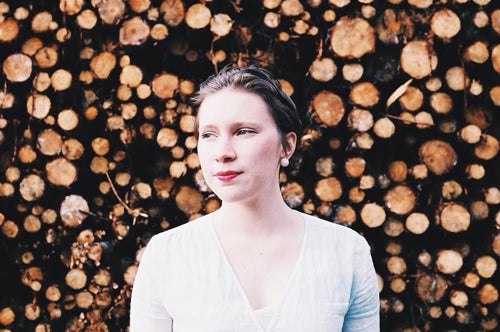
Climate change: Are women more vulnerable than men?
Waterloo’s recent Trudeau Foundation scholarship winner talks about how climate change magnifies gender inequality

Waterloo’s recent Trudeau Foundation scholarship winner talks about how climate change magnifies gender inequality
By Sam Toman Faculty of Environment
Credit: Emily Avelar
University of Waterloo doctoral student Tahnee Prior was recently awarded a prestigious Trudeau Foundation scholarship for her work on the future of Arctic governance.
Prior, a global governance PhD student at Waterloo's Balsillie School of International Affairs, hopes to define a new governance framework that will address the complex issues caused by climate change, resource extraction, migration and potential inter-state conflict in the Arctic.
We asked Prior to talk about how women in particular are affected by climate change:
The effects of climate change will be felt most deeply by marginalized groups who have contributed least to carbon emissions, but are most vulnerable due to economic, social, environmental, geographic, demographic, and cultural factors.
Women fall within the category of such vulnerable groups. The correlation between wealth, climate resilience, and gender equality are not new. Many international reports, from the UN to the World Economic Forum, highlight that climate change magnifies existing patterns of gender inequality including existing social norms and power structures.
These reports show that women are disproportionately impacted for two reasons in particular: historical inequalities and women’s dependence on the sectors and resources set to experience intense shifts. While women predominate in world food production (at 50 to 80 percent), they own only one percent of the world’s property. They lack land and ownership rights for their means of production.
Women and girls are often required to travel long distances to secure water and fuel wood which leaves them vulnerable to physical attacks and harassment; disaster warnings often take place in public spaces that many women lack access to; and natural disasters often disrupt local security safety nets and the breakdown of normal social control and protections.
Women still face ongoing disadvantages in their access to economic and social resources: bargaining power in households, communities, nationally, and internationally; access to land, financing; technology; social capital; as well as training in climate adaptation and disaster prevention. Such inequalities prevent women from engaging in existing processes, hindering their ability to respond to climate change as it happens.
While there is often a notion that women should be at the table because they fall within the category of vulnerable or marginalized groups, women should, in fact, participate because they can contribute valuable alternative perspectives, experiences, and context-specific knowledge that can help address existing obstacles and enhance local innovation.
The climate change debate has been largely gender blind and often limited to short-term interventions. It is often slow to systematically integrate gender into its policies and processes, which means that women are often an afterthought. Instead, gender considerations should be central to policy-making, matching commitments for their practical implementation. A range of solutions can have significant impact on climate management: predictable climate financing; resources for reconciling loss and damage incurred from climate inaction; gender-equitable public participation in decision-making; periodic gender equality impact assessments; and benefit sharing.
Mechanisms for gathering and analyzing disaggregated data are also crucial for evidence-based policy-making and reporting.
Some of my research focuses on the impact of climate change on women in the Arctic, which faces its own set of challenges. New opportunities for resources extraction, partly resulting from climate change, offer tempting short term gains that have new actors moving northward. But the risks associated with resource development on northern communities and ecosystems remains uncertain due to a lack of scientific data and empirical research.
An often understudied social vulnerability that is manifesting itself, but rarely spoken of, is an increase in human trafficking in the Circumpolar North. A combination of development, demographic shifts, and a lack of accountability can be disastrous for Arctic communities, from Alaska to northern Russia. Ways of mitigating such risk factors is the inclusion of more women in decision-making roles in natural resource management and the gathering of quantitative data.
There are many, some of which aren’t specific to the Circumpolar North. The Balsillie School of International Affairs and the University of Waterloo’s Faculty of Environment, where I’m currently a PhD Candidate, are incredible resources for me to learn about the ins and outs of environmental governance on both a global and local scale.
I’ve also spent a significant amount of time in northern Finland, a place that now very much feels like home. While in Rovaniemi, I worked at an interdisciplinary research centre with lawyers, anthropologists, climate scientists, glaciologists, economists, and industrial designers to better understand the many challenges that we face in Arctic. It’s what ultimately led me to research the Circumpolar North in a more holistic way.
Most recently, I returned to Waterloo from a month spent in Reykjavik. While in Iceland, I was fortunate enough to spend a wind-blown and rainy weekend on a farm where I ran a workshop on how we build resilient global communities. The meeting was a part of Saga Fest, a gathering for researchers, politicians, and community leaders to share their work on sustainability issues in Iceland and beyond. It was an incredible opportunity to share stories and learn about the glaciers and the significant change that they are set to experience by 2120.

Read more
Special issue of Waterloo Magazine celebrates women who lead, and explores equity in education and the workplace

Read more
University of Waterloo researchers discuss the challenges faced by researchers amid rising antagonism in climate science discourse

Read more
Waterloo announces winners of annual award for co-op students from each of the six faculties
The University of Waterloo acknowledges that much of our work takes place on the traditional territory of the Neutral, Anishinaabeg and Haudenosaunee peoples. Our main campus is situated on the Haldimand Tract, the land granted to the Six Nations that includes six miles on each side of the Grand River. Our active work toward reconciliation takes place across our campuses through research, learning, teaching, and community building, and is co-ordinated within the Office of Indigenous Relations.